Digital aerial seabird and cetacean surveys off the east coast of Scotland
This report provides eight digital aerial surveys of seabirds and marine mammals across the seas east of Scotland between February 2020-January 2021, a task driven by the need of updating existing data. The main difference was seen in seabird distribution, with little change to cetacean abundance.
3. Distribution
Survey accounts have been provided below, which includes survey collection summary, raw count tables of avian species, raw count tables of other marine megafauna, summary of anthropological targets and distribution maps of all targets found during the survey. For more detail on species groupings see Appendix I.
3.1. Survey 1 – Winter 2019/2020
Survey 1 was conducted in winter 2019/2020 over three days, transects one and two were collected over 12 February and 6 March, transects three and four on 13 February, transects five over 13 February and 4 March, and data for all remaining transects (six, seven, eight, nine and 10) were collected on 4 March (Figure 2). The total coverage collected for this survey represented 1.94% of the wider survey area.
A total of 10,282 birds were recorded in the survey area during Survey 1 (Table 5). The most abundant species recorded was guillemot/razorbill (n=5,720), followed by fulmar (n=1,838), kittiwake (n=794), large gull species (n=411), auk species (n=393), gannet (n=377), herring gull (n=271), small gull species (n=245), great black-backed gull (n=184), puffin (n=29), common gull (n=13), lesser black-backed gull (n=3), black-backed gull species (n=2), gull species (n=1) and razorbill (n=1).
A total of 2,123 birds (21%) were recorded in flight during this survey, these consisted of fulmar (n=967), kittiwake (n=633), gannet (n=183), guillemot/razorbill (n=127), herring gull (n=100), great black-backed gull (n=66), large gull species (n=22), common gull (n=13), small gull species (n=6), auk species (n=4), gull species (n=1), lesser black-backed gull (n=1). There were 8,154 birds (79%) recorded as sitting. There were 4 birds (<1%) recorded as diving.
| Species | Flying | Sitting | Diving | Total |
|---|---|---|---|---|
| Kittiwake | 634 | 160 | - | 794 |
| Common Gull | 13 | - | - | 13 |
| Small Gull sp. – unidentified | 6 | 239 | - | 245 |
| Great Black-backed Gull | 66 | 118 | - | 184 |
| Herring Gull | 100 | 171 | - | 271 |
| Lesser Black-backed Gull | 1 | 2 | - | 3 |
| Black-backed Gull sp. – unidentified | - | 2 | - | 2 |
| Large Gull sp. – unidentified | 22 | 389 | - | 411 |
| Gull sp. - unidentified | 1 | - | - | 1 |
| Razorbill | - | 1 | - | 1 |
| Guillemot / Razorbill | 127 | 5,589 | 4 | 5,720 |
| Puffin | - | 29 | - | 29 |
| Auk sp. – unidentified | 4 | 389 | - | 393 |
| Fulmar | 967 | 871 | - | 1,838 |
| Gannet | 183 | 194 | - | 377 |
| Total | 2,124 | 8,154 | 4 | 10,282 |
A total of 96 marine mammals were recorded in the survey area during Survey 1 (Table 6), these were recorded as dolphin/porpoise (n=51), dolphin species (n=27), grey seal (n=6), common dolphin (n=5), phocids (n=3), white-beaked dolphin (n=3) and common minke whale (n=1).
| Species | Submerged | Surfacing | Total |
|---|---|---|---|
| Grey Seal | 2 | 4 | 6 |
| Seal sp. – unidentified | 1 | 2 | 3 |
| Common Minke Whale | 1 | - | 1 |
| Common Dolphin | 4 | 1 | 5 |
| White-beaked Dolphin | 1 | 2 | 3 |
| Dolphin sp. – unidentified | 22 | 5 | 27 |
| Dolphin / Porpoise | 35 | 16 | 51 |
| Total marine mammals | 66 | 30 | 96 |
A total of eight anthropogenic objects were recorded in the survey area during Survey 1, these were recorded as platform (n=4), fishing vessel (n=2), supply vessel (n=1) and wind turbine (n=1).
shows the location of all birds and marine megafauna recorded throughout the survey area during Winter 2019 / 2020 (Survey 1).
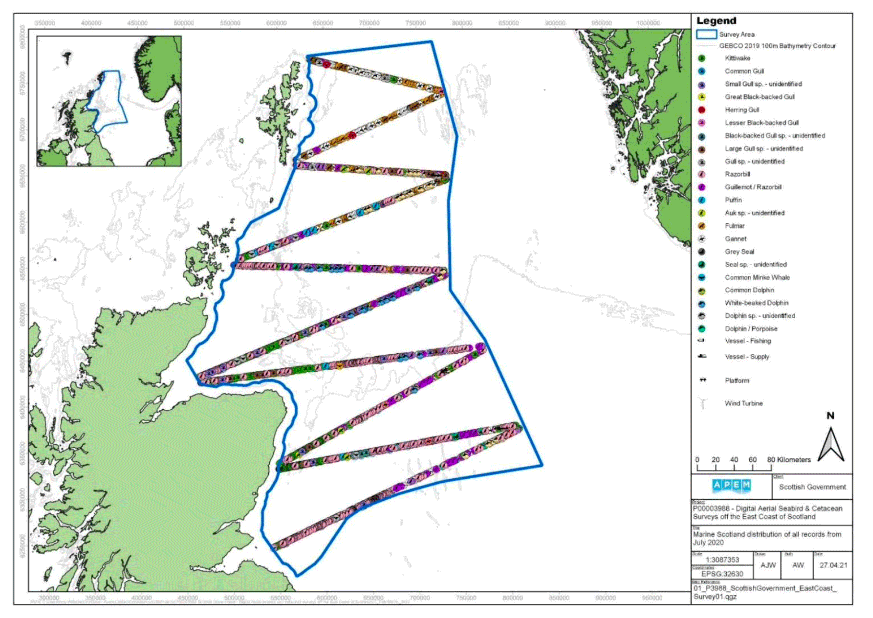
Figure Note: Individuals may appear to overlap if they are in close proximity to each other.
3.2. Survey 2 – Spring 2020
Survey 2 was conducted over three days and all flight lines were successfully completed. Data for transects one and two were collected on 13 April, transects three, four, five and six on 14 April, and transects seven, eight, nine and ten on 16 April (Figure 3). The total coverage collected for this survey represented 1.43% of the wider survey area, this lower than expected due to a camera malfunction.
A total of 9,606 birds were recorded in the survey area during Survey 2 (Table 7). The most abundant species recorded was guillemot / razorbill (n=4,230), followed by kittiwake (n=1,356), fulmar (n=1,300), razorbill (n=1,043), gannet (n=720), guillemot (n=701), auk species (n=87), puffin (n=74), small gull species (n=31), great black-backed gull (n=21), large gull species (n=21), herring gull (n=14), common gull (n=2), gull species (n=2), black guillemot (n=1), great northern diver (n=1), great skua (n=1) and lesser black-backed gull (n=1).
A total of 2,720 birds (28%) were recorded in flight during this survey, these consisted of kittiwake (n=1,068), fulmar (n=996), gannet (n=505), guillemot (n=67), guillemot / razorbill (n=60), small gull species (n=7), auk species (n=5), great black-backed gull (n=3), common gull (n=2), herring gull (n=2), large gull species (n=2), great skua (n=1), gull species (n=1) and razorbill (n=1). There were 6,886 birds (72%) recorded as sitting.
| Species | Flying | Sitting | Total |
|---|---|---|---|
| Kittiwake | 1,068 | 288 | 1,356 |
| Common Gull | 2 | - | 2 |
| Small Gull sp. – unidentified | 7 | 24 | 31 |
| Great Black-backed Gull | 3 | 18 | 21 |
| Herring Gull | 2 | 12 | 14 |
| Lesser Black-backed Gull | - | 1 | 1 |
| Large Gull sp. – unidentified | 2 | 19 | 21 |
| Gull sp. – unidentified | 1 | 1 | 2 |
| Great Skua | 1 | - | 1 |
| Guillemot | 67 | 634 | 701 |
| Razorbill | 1 | 1,042 | 1,043 |
| Guillemot / Razorbill | 60 | 4,170 | 4,230 |
| Black Guillemot | - | 1 | 1 |
| Puffin | - | 74 | 74 |
| Auk sp. – unidentified | 5 | 82 | 87 |
| Great Northern Diver | - | 1 | 1 |
| Fulmar | 996 | 304 | 1,300 |
| Gannet | 505 | 215 | 720 |
| Total | 2,720 | 6,886 | 9,606 |
A total of 22 marine mammals were recorded in the survey area during Survey 2 (Table 8), these were recorded as dolphin / porpoise (n=13), common minke whale (n=3), phocids (n=3), dolphin species (n=2) and grey seal (n=1).
| Species | Submerged | Surfacing | Total |
|---|---|---|---|
| Grey Seal | 1 | - | 1 |
| Seal sp. – unidentified | 2 | 1 | 3 |
| Common Minke Whale | 3 | - | 3 |
| Dolphin sp. – unidentified | 2 | - | 2 |
| Dolphin / Porpoise | 7 | 6 | 13 |
| Total marine mammals | 15 | 7 | 22 |
A total of five anthropogenic objects were recorded in the survey area during Survey 2, these were recorded as platform (n=2), fishing vessel (n=1), supply vessel (n=1) and wind turbine (n=1).
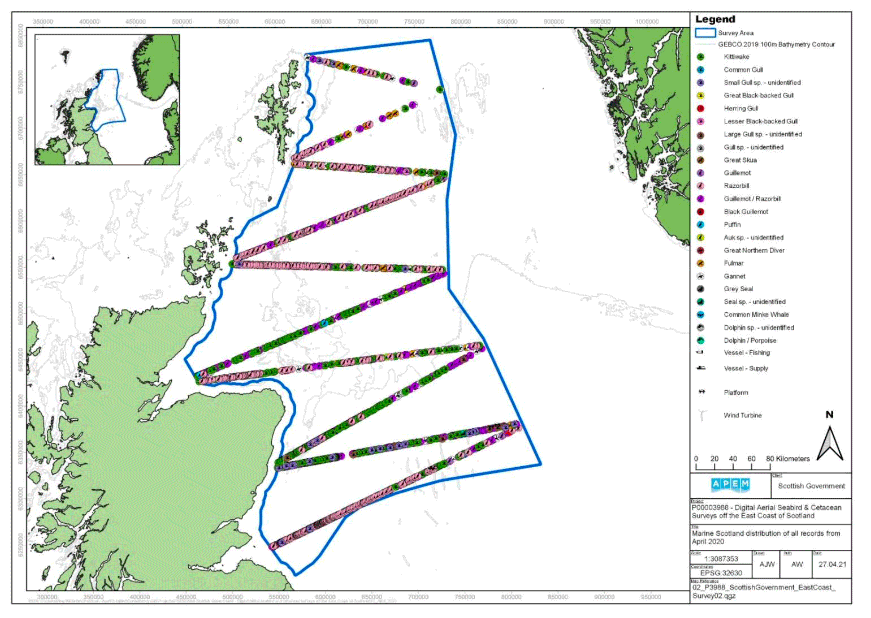
Figure Note: Individuals may appear to overlap if they are in close proximity to each other.
3.3. Survey 3 – Summer I 2020
Survey 3 was conducted over four days and all flight lines were successfully completed. Data for transects one and two were collected on 2 June, transect three on 8 June, transect four over 8 June and 24 June, transect five, six, seven and eight on 24 June, and transects nine and ten on 26 June (Figure 4). The total coverage collected for this survey represented 1.94% of the wider survey area.
A total of 18,141 birds were recorded in the survey area during Survey 3 (Table 9)
The most abundant species recorded was guillemot (n=4,371), followed by kittiwake (n=3,718), razorbill (n=2,843), guillemot / razorbill (n=2,370), fulmar (n=2,056), gannet (n=1,773), herring gull (n=301), auk species (n=254), puffin (n=251), small gull species (n=59), large gull species (n=44), great skua (n=28), lesser black-backed gull (n=17), 'commic' tern (n=13), gull species (n=7), black guillemot (n=6), curlew (n=5), great black-backed gull (n=4), storm petrel (n=4), Arctic skua (n=3), Manx shearwater (n=3), black-backed gull species (n=2), common tern (n=2), tern species (n=2), cormorant / shag (n=1), great northern diver (n=1), red-throated diver (n=1), skua species (n=1) and unidentified bird species (n=1).
A total of 4,720 birds (26%) were recorded in flight during this survey, these consisted of kittiwake (n=2,067), fulmar (n=909), gannet (n=909), guillemot (n=406), herring gull (n=174), razorbill (n=106), guillemot / razorbill (n=65), great skua (n=26), auk species (n=16), 'commic' tern (n=13), puffin (n=6), curlew (n=5), lesser black-backed gull (n=4), Arctic skua (n=3), large gull species (n=3), Manx shearwater (n=3), common tern (n=2), tern species (n=2) and great black-backed gull (n=1). There were 13,417 birds (74%) recorded as sitting. There were three birds (<1%) recorded as diving, and one bird (<1%) recorded as perched.
| Species | Flying | Sitting | Diving | Perched | Total |
|---|---|---|---|---|---|
| Curlew | 5 | - | - | - | 5 |
| Kittiwake | 2,067 | 1,651 | - | - | 3,718 |
| Small Gull sp. – unidentified | - | 59 | - | - | 59 |
| Great Black-backed Gull | 1 | 3 | - | - | 4 |
| Herring Gull | 174 | 127 | - | - | 301 |
| Lesser Black-backed Gull | 4 | 13 | - | - | 17 |
| Black-backed Gull sp. – unidentified | - | 2 | - | - | 2 |
| Large Gull sp. – unidentified | 3 | 40 | - | 1 | 44 |
| Gull sp. – unidentified | - | 7 | - | - | 7 |
| Common Tern | 2 | - | - | - | 2 |
| 'Commic' Tern | 13 | - | - | - | 13 |
| Tern sp. – unidentified | 2 | - | - | - | 2 |
| Great Skua | 26 | 2 | - | - | 28 |
| Arctic Skua | 3 | - | - | - | 3 |
| Skua sp. – unidentified | - | 1 | - | - | 1 |
| Guillemot | 406 | 3,964 | 1 | - | 4,371 |
| Razorbill | 106 | 2,737 | - | - | 2,843 |
| Guillemot / Razorbill | 65 | 2,304 | 1 | - | 2,370 |
| Black Guillemot | - | 6 | - | - | 6 |
| Puffin | 6 | 245 | - | - | 251 |
| Auk sp. – unidentified | 16 | 238 | - | - | 254 |
| Red-throated Diver | - | 1 | - | - | 1 |
| Great Northern Diver | - | 1 | - | - | 1 |
| Storm Petrel sp. – unidentified | - | 4 | - | - | 4 |
| Fulmar | 909 | 1,147 | - | - | 2,056 |
| Manx Shearwater | 3 | - | - | - | 3 |
| Gannet | 909 | 863 | 1 | - | 1,773 |
| Cormorant / Shag | - | 1 | - | - | 1 |
| Bird sp. – unidentified | - | 1 | - | - | 1 |
| Total | 4,720 | 13,417 | 3 | 1 | 18,141 |
A total of 517 marine mammals were recorded in the survey area during Survey 3 (Table 10), these were recorded as dolphin/porpoise (n=249), harbour porpoise (n=128), marine mammal species (n=29), phocids (n=29), dolphin species (n=24), common dolphin (n=22), common minke whale (n=12), grey seal (n=11), white-beaked dolphin (n=10) and whale species (n=3).
A total of one other marine species was recorded in the survey area during Survey 3 (Table 10), this was recorded as shark species (n=1).
| Species | Submerged | Surfacing | Total |
|---|---|---|---|
| Grey Seal | 10 | 1 | 11 |
| Seal sp. – unidentified | 25 | 4 | 29 |
| Common Minke Whale | 11 | 1 | 12 |
| Whale sp. – unidentified | 3 | - | 3 |
| White-beaked Dolphin | 8 | 2 | 10 |
| Common Dolphin | 20 | 2 | 22 |
| Dolphin sp. – unidentified | 19 | 5 | 24 |
| Dolphin / Porpoise | 228 | 21 | 249 |
| Harbour Porpoise | 108 | 20 | 128 |
| Marine Mammal sp. – unidentified | 28 | 1 | 29 |
| Total marine mammals | 460 | 57 | 517 |
| Shark sp. – unidentified | 1 | - | 1 |
| Total other marine megafauna | 1 | - | 1 |
A total of 18 anthropogenic objects were recorded in the survey area during Survey 3, these were recorded as fishing vessel (n=7), platform (n=5), supply vessel (n=3), cargo ship (n=2) and wind turbine (n=1).
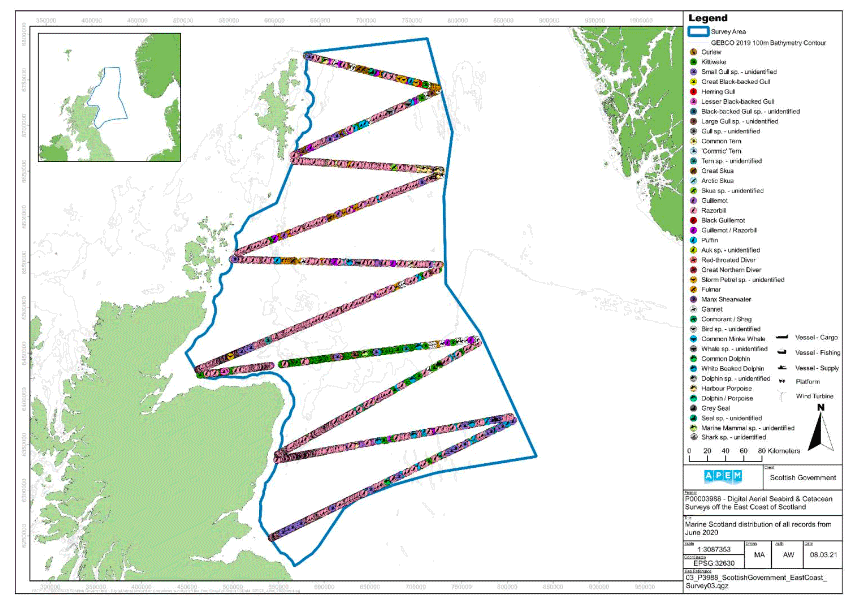
3.4. Survey 4 – Summer II 2020
Survey 4 was conducted over two days and all flight lines were successfully completed. Data for transects five, six, seven, eight nine and 10 were collected on 18 July and transects one, two, three and four on 19 July (Figure 5). The total coverage collected for this survey represented 2% of the wider survey area.
A total of 14,284 birds were recorded in the survey area during Survey 4 (Table 11). The most abundant species recorded was fulmar (n=2,906), followed by kittiwake (n=2,802), guillemot (n=2,713), guillemot / razorbill (n=1,694), gannet (n=1,582), razorbill (n=1,397), 'commic' tern (n=384), auk species (n=243), herring gull (n=148), wader species (n=87), large gull species (n=67), puffin (n=65), small gull species (n=40), great skua (n=33), tern species (n=31), redshank (n=28), gull species (n=17), great black-backed gull (n=11), lesser black-backed gull (n=10), Manx shearwater (n=9), skua species (n=5), common gull (n=3), red-throated diver (n=3), diver species (n=2), storm petrel species (n=2), Arctic skua (n=1) and black-backed gull species (n=1).
A total of 4,584 birds (32%) were recorded in flight during this survey, these consisted of fulmar (n=1,841), kittiwake (n=1,159), gannet (n=973), 'commic' tern (n=255), wader species (n=87), guillemot (n=57), herring gull (n=54), great skua (n=31), redshank (n=28), razorbill (n=25), guillemot / razorbill (n=21), auk species (n=9), Manx shearwater (n=9), great black-backed gull (n=7), lesser black-backed gull (n=7), small gull species (n=6), puffin (n=5), large gull species (n=4), common gull (n=3), Arctic skua (n=1), gull species (n=1) and skua species (n=1). There were 9,696 birds (68%) recorded as sitting. There were four birds (<1%) recorded as diving.
| Species | Flying | Sitting | Diving | Total |
|---|---|---|---|---|
| Redshank | 28 | - | - | 28 |
| Wader sp. – unidentified | 87 | - | - | 87 |
| Kittiwake | 1,159 | 1,643 | - | 2,802 |
| Common Gull | 3 | - | - | 3 |
| Small Gull sp. – unidentified | 6 | 34 | - | 40 |
| Great Black-backed Gull | 7 | 4 | - | 11 |
| Herring Gull | 54 | 94 | - | 148 |
| Lesser Black-backed Gull | 7 | 30 | - | 10 |
| Black-backed Gull sp. – unidentified | - | 1 | - | 1 |
| Large Gull sp. – unidentified | 4 | 63 | - | 67 |
| Gull sp. – unidentified | 1 | 16 | - | 17 |
| 'Commic' Tern | 255 | 129 | - | 384 |
| Tern sp. – unidentified | - | 31 | - | 31 |
| Great Skua | 31 | 2 | - | 33 |
| Arctic Skua | 1 | - | - | 1 |
| Skua sp. – unidentified | 1 | 4 | - | 5 |
| Guillemot | 57 | 2,656 | - | 2,713 |
| Razorbill | 25 | 1,371 | 1 | 1,397 |
| Guillemot / Razorbill | 21 | 1,673 | - | 1,694 |
| Puffin | 5 | 60 | - | 65 |
| Auk sp. – unidentified | 9 | 233 | 1 | 243 |
| Red-throated Diver | - | 3 | - | 3 |
| Diver sp. – unidentified | - | 2 | - | 2 |
| Storm Petrel sp. – unidentified | - | 2 | - | 2 |
| Fulmar | 1,841 | 1,065 | - | 2,906 |
| Manx Shearwater | 9 | - | - | 9 |
| Gannet | 973 | 607 | 2 | 1,582 |
| Total | 4,584 | 9,696 | 4 | 14,284 |
A total of 660 marine mammals were recorded in the survey area during Survey 4 (Table 12), these were recorded as dolphin / porpoise (n=293), harbour porpoise (n=250), white-beaked dolphin (n=71), dolphin species (n=17), seal species (n=16), grey seal (n=7), common minke whale (n=3) and marine mammal species (n=3).
| Species | Submerged | Surfacing | Total |
|---|---|---|---|
| Grey Seal | 5 | 2 | 7 |
| Seal sp. – unidentified | 11 | 5 | 16 |
| Common Minke Whale | 1 | 2 | 3 |
| White-beaked Dolphin | 60 | 11 | 71 |
| Dolphin sp. – unidentified | 15 | 2 | 17 |
| Harbour Porpoise | 223 | 27 | 250 |
| Dolphin / Porpoise | 265 | 28 | 293 |
| Marine Mammal sp. - unidentified | 3 | - | 3 |
| Total marine mammals | 583 | 77 | 660 |
A total of 13 anthropogenic objects were recorded in the survey area during Survey 4, these were recorded as platform (n=4), fishing vessel (n=3), supply vessel (n=2), unidentified vessel (n=2), cargo ship (n=1) and wind turbine (n=1).
Figure 13 shows the location of all birds and marine megafauna recorded throughout the survey area during Summer survey II (Survey 4).
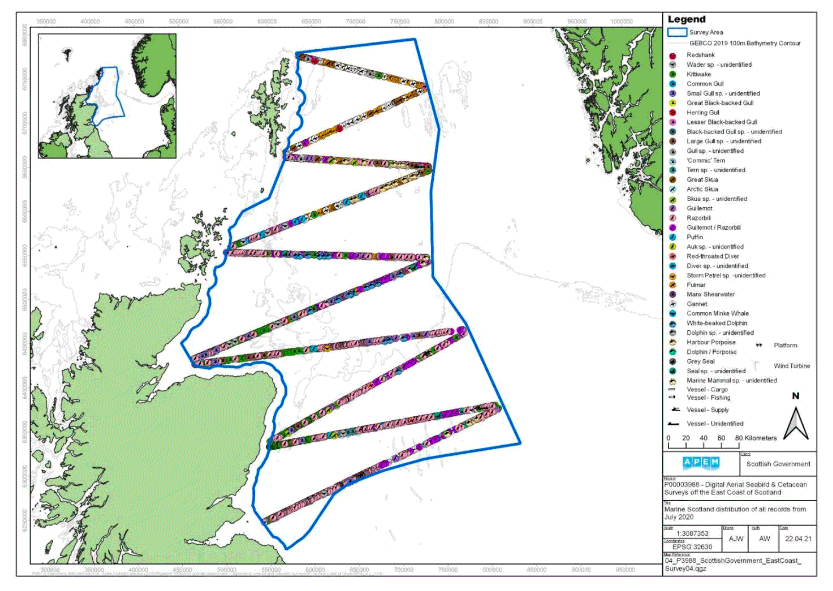
Figure Note: Individuals may appear to overlap if they are in close proximity to each other.
1.1 3.5. Survey 5 – Autumn I 2020
Survey 5 was conducted over three days and all flight lines were successfully completed. Data for transects seven, eight, nine and ten were collected on 16 September, transects three, four, five and six on 17 September, and transects one and two on 18 September (Figure 6). The total coverage collected for this survey represented 1.94% of the wider survey area.
A total of 64,034 birds were recorded in the survey area during Survey 5 (Table 13). The most abundant species recorded was guillemot/razorbill (n=38,482), followed by kittiwake (n=9,178), fulmar (n=8,003), guillemot (n=3,311), gannet (n=3,012), razorbill (n=996), auk species (n=365), great black-backed gull (n=223), large gull species (n=170), small gull species (n=119), black-backed gull species (n=31), great skua (n=31), Manx shearwater (n=22), herring gull (n=20), gull species (n=18), puffin (n=12), red-throated diver (n=11), common gull (n=8), diver species (n=7), skua species (n=7), 'commic' tern (n=3), Arctic skua (n=2), common eider (n=1), great northern diver (n=1) and shearwater species (n=1).
A total of 7,947 birds (12%) were recorded in flight during this survey, these consisted of kittiwake (n=3,883), fulmar (n=2,186), gannet (n=1,518), guillemot/razorbill (n=131), great black-backed gull (n=69), large gull species (n=40), great skua (n=31), Manx shearwater (n=22), black-backed gull species (n=19), herring gull (n=16), common gull (n=6), razorbill (n=6), small gull species (n=3), 'commic' tern (n=3), guillemot (n=3), auk species (n=3), Arctic skua (n=2), puffin (n=2), skua species (n=2), red-throated diver (n=1) and diver species (n=1). There were 56,063 birds (88%) recorded as sitting and 24 birds recorded as diving.
| Species | Flying | Sitting | Diving | Total |
|---|---|---|---|---|
| Common Eider | - | 1 | - | 1 |
| Kittiwake | 3,883 | 5,295 | - | 9,178 |
| Common Gull | 6 | 2 | - | 8 |
| Small Gull sp. - unidentified | 3 | 116 | - | 119 |
| Great Black-backed Gull | 69 | 154 | - | 223 |
| Herring Gull | 16 | 4 | - | 20 |
| Black-backed Gull sp. - unidentified | 19 | 12 | - | 31 |
| Large Gull sp. - unidentified | 40 | 130 | - | 170 |
| Gull sp. - unidentified | - | 18 | - | 18 |
| 'Commic' Tern | 3 | - | - | 3 |
| Great Skua | 31 | - | - | 31 |
| Arctic Skua | 2 | - | - | 2 |
| Skua sp. - unidentified | 2 | 5 | - | 7 |
| Guillemot | 3 | 3,308 | - | 3,311 |
| Razorbill | 6 | 990 | - | 996 |
| Guillemot / Razorbill | 131 | 38,350 | 1 | 38,482 |
| Puffin | 2 | 10 | - | 12 |
| Auk sp. - unidentified | 3 | 362 | - | 365 |
| Red-throated Diver | 1 | 10 | - | 11 |
| Great Northern Diver | - | 1 | - | 1 |
| Diver sp. - unidentified | 1 | 6 | - | 7 |
| Fulmar | 2,186 | 5,817 | - | 8,003 |
| Manx Shearwater | 22 | - | - | 22 |
| Shearwater sp. - unidentified | - | 1 | - | 1 |
| Gannet | 1,518 | 1,471 | 23 | 3,012 |
| Total | 7,947 | 56,063 | 24 | 64,034 |
A total of 58 marine mammals were recorded in the survey area during Survey 5 (Table 14), these were recorded as dolphin/porpoise (n=18), white-beaked dolphin (n=12), common minke whale (n=8), harbour porpoise (n=8), dolphin species (n=5), seal species (n=4), grey seal (n=2) and marine mammal species (n=1).
A total of one other marine megafauna species was recorded in the survey area during Survey 5, this was recoded as basking shark (n=1).
| Species | Submerged | Surfacing | Total |
|---|---|---|---|
| Common Minke Whale | 5 | 3 | 8 |
| White-beaked Dolphin | 10 | 2 | 12 |
| Dolphin sp. - unidentified | 3 | 2 | 5 |
| Harbour Porpoise | 6 | 2 | 8 |
| Dolphin / Porpoise | 12 | 6 | 18 |
| Grey Seal | 1 | 1 | 2 |
| Seal sp. - unidentified | - | 4 | 4 |
| Marine Mammal sp. - unidentified | - | 1 | 1 |
| Total marine mammals | 37 | 21 | 58 |
| Basking Shark | 1 | - | 1 |
| Total other marine megafauna | 1 | - | 1 |
A total of 13 anthropogenic objects were recorded in the survey area during Survey 5, these were recorded as fishing vessel (n=4), platform (n=3), cargo ship (n=2), supply vessel (n=2), wind turbine (n=1) and fixed structure (buoy, rigs etc.; n=1).
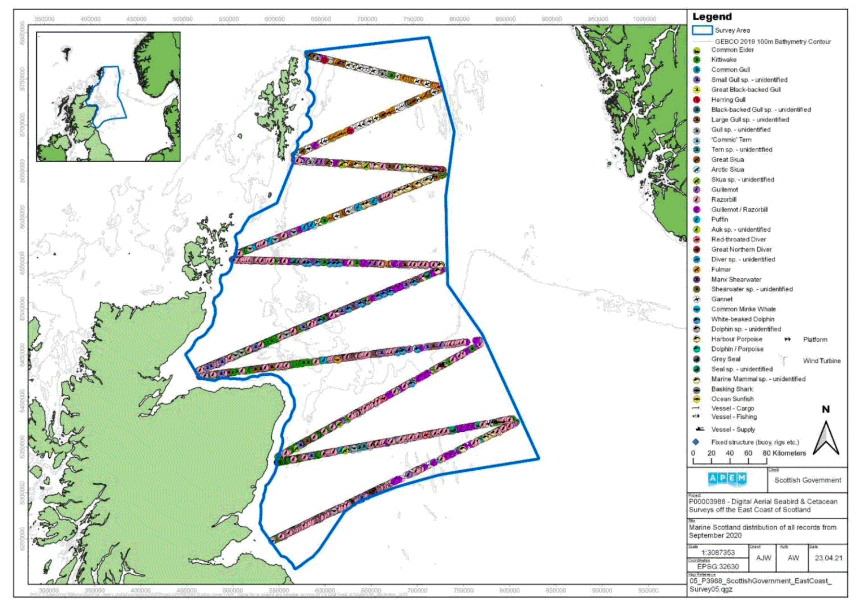
Figure Note: Individuals may appear to overlap if they are in close proximity to each other.
3.6. Survey 6 – Autumn II 2020
Survey 6 was conducted over four days and all flight lines were successfully completed. Data for transects one and two were collected on 27 October, transects six, seven, eight, nine, and ten on 29 October, transects four and five on 30 September, and transects three on 6 November (Figure 7). The total coverage collected for this survey represented 1.94% of the wider survey area.
A total of 19,551 birds were recorded during Survey 6 (Table 15). The most abundant species recorded was guillemot/razorbill (n=8,434), followed by fulmar (n=5,384), gannet (n=2,146), kittiwake (n=903), great black-backed gull (n=532), guillemot (n=469), large gull species (n=449), razorbill (n=455), herring gull (n=378), gull species (n=168), small gull species (n=81), auk species (n=65), common gull (n=35), black-backed gull species (n=25), wader species (n=7), puffin (=6), great skua (n=5), skua species (n=2), red-throated diver (n=2), diver species (n=2), black-headed gull (n=1), great northern diver (n=1) and shag (n=1).
A total of 4,720 birds (24%) were recorded in flight during this survey, these consisted of fulmar (n=2,609), gannet (n=855), kittiwake (n=642), herring gull (n=214), great black-backed gull (n=143), guillemot / razorbill (n=107), large gull species (n=48), common gull (n=35), guillemot (n=28), auk species (n=10), wader species (n=7), gull species (n=5), great skua (n=5), black-backed gull species (n=4), razorbill (n=3), small gull species (n=2), black-headed gull (n=1), diver species (n=1) and shag (n=1). There were 14,813 birds (76%) recorded as sitting, 17 birds recorded as perched (<1%) and one bird recorded as diving (<1%)
| Species | Flying | Sitting | Diving | Perched | Total |
|---|---|---|---|---|---|
| Wader sp. – unidentified | 7 | - | - | - | 7 |
| Kittiwake | 642 | 261 | - | - | 903 |
| Black-headed Gull | 1 | - | - | - | 1 |
| Common Gull | 35 | - | - | - | 35 |
| Small Gull sp. – unidentified | 2 | 79 | - | - | 81 |
| Great Black-backed Gull | 143 | 372 | - | 17 | 532 |
| Herring Gull | 214 | 164 | - | - | 378 |
| Black-backed Gull sp. – unidentified | 4 | 21 | - | - | 25 |
| Large Gull sp. – unidentified | 48 | 401 | - | - | 449 |
| Gull sp. – unidentified | 5 | 163 | - | - | 168 |
| Great Skua | 5 | - | - | - | 5 |
| Skua sp. – unidentified | - | 2 | - | - | 2 |
| Guillemot | 28 | 441 | - | - | 469 |
| Razorbill | 3 | 452 | - | - | 455 |
| Guillemot / Razorbill | 107 | 8,327 | - | - | 8,434 |
| Puffin | - | 6 | - | - | 6 |
| Auk sp. – unidentified | 10 | 54 | 1 | - | 65 |
| Red-throated Diver | - | 2 | - | - | 2 |
| Great Northern Diver | - | 1 | - | - | 1 |
| Diver sp. – unidentified | 1 | 1 | - | - | 2 |
| Fulmar | 2,609 | 2,775 | - | - | 5,384 |
| Gannet | 855 | 1,291 | - | - | 2,146 |
| Shag | 1 | - | - | - | 1 |
| Total birds | 4,720 | 14,813 | 1 | 17 | 19,551 |
A total of 84 marine mammals were recorded in the survey area during Survey 6 (Table 16), these were recorded as harbour porpoise (n=34), white-beaked dolphin (n=20), dolphin/porpoise (n=18), seal species (n=4), common minke whale (n=4), marine mammal species (n=3) and whale species (n=1).
A total of one other marine megafauna species was recorded in the survey area during Survey 6, this was recoded as ocean sunfish (n=1).
| Species | Submerged | Surfacing | Total |
|---|---|---|---|
| Seal sp. – unidentified | 4 | - | 4 |
| Common Minke Whale | 2 | 2 | 4 |
| Whale sp. – unidentified | 1 | - | 1 |
| White-beaked Dolphin | 18 | 2 | 20 |
| Harbour Porpoise | 33 | 1 | 34 |
| Dolphin / Porpoise | 14 | 4 | 18 |
| Marine Mammal sp. – unidentified | 3 | - | 3 |
| Total marine mammals | 75 | 9 | 84 |
| Ocean Sunfish | 1 | - | 1 |
| Total other marine megafauna | 1 | - | 1 |
A total of 12 anthropogenic objects were recorded in the survey area during Survey 6, these were recorded as supply vessel (n=6), platform (n=4), fixed structure (buoy, rigs etc.; n=1) and wind turbine (n=1).
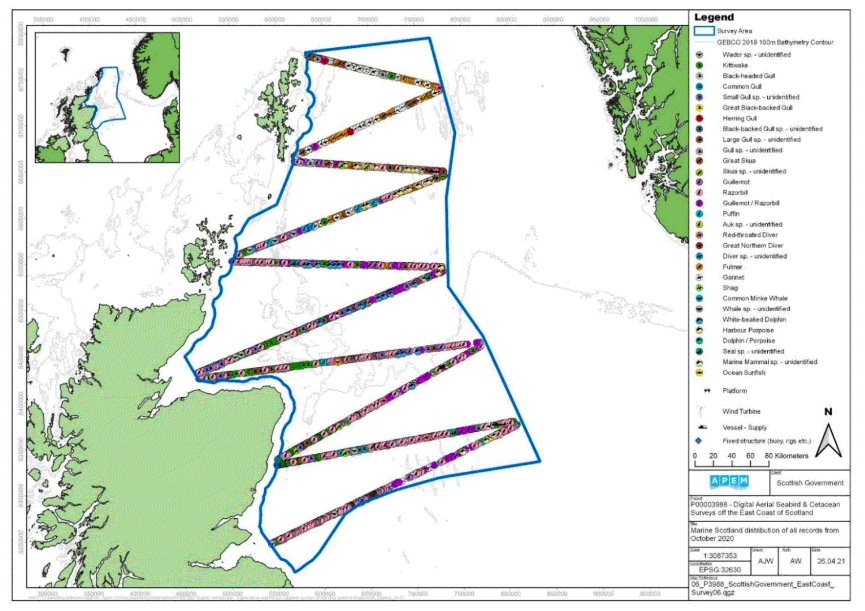
Figure Note: Individuals may appear to overlap if they are in close proximity to each other.
1.1 3.7. Survey 7 – Winter 2020 / 2021
Survey 7 was conducted over five days and all flight lines were successfully completed. Data for transects one and two were collected on 27 November, transects seven and eight on 29 November, transects three and four on 17 January, transects five and six on 19 January, and transects nine and ten on 23 March (Figure 8). The total coverage collected for this survey represented 1.67% of the wider survey area.
A total of 14,525 birds were recorded during Survey 7 (Table 17, Table 15). The most abundant species recorded was guillemot/razorbill (n=7,246), followed by fulmar (n=3,284), gannet (n=1,088), kittiwake (n=982), herring gull (n=705), great black-backed gull (n=483), guillemot (n=246), large gull species (n=224), auk species (n=142), small gull species (n=35), common gull (n=29), black-backed gull species (n=27), gull species (n=11), knot (n=5), diver species (n=3), long-tailed duck (n=3), glaucous gull (n=2), great skua (n=2), lesser black-backed gull (n=2), black guillemot (n=1), grebe species (n=1), Iceland gull (n=1), red-breasted merganser (n=1), red-throated diver (n=1) and velvet scoter (n=1).
A total of 3,881 birds (26%) were recorded in flight during this survey, these consisted of fulmar (n=2,171), kittiwake (n=770), gannet (n=366), herring gull (n=240), great black-backed gull (n=157), guillemot / razorbill (n=51), large gull species (n=43), common gull (n=29), guillemot (n=19), auk species (n=7), small gull species (n=6), gull species (n=5), knot (n=5), black-backed gull species (n=3), long-tailed duck (n=3), great skua (n=2), glaucous gull (n=1), lesser black-backed gull (n=1), red-breasted merganser (n=1) and velvet scoter (n=1). There were 10,631 birds (73%) recorded as sitting, 12 birds recorded as perched (<1%) and one bird recorded as deceased (<1%)
| Species | Flying | Sitting | Perched | Deceased | Total |
|---|---|---|---|---|---|
| Velvet Scoter | 1 | - | - | - | 1 |
| Long-tailed Duck | 3 | - | - | - | 3 |
| Red-breasted Merganser | 1 | - | - | - | 1 |
| Grebe sp. – unidentified | - | 1 | - | - | 1 |
| Knot | 5 | - | - | - | 5 |
| Kittiwake | 770 | 212 | - | - | 982 |
| Common Gull | 29 | - | - | - | 29 |
| Small Gull sp. – unidentified | 6 | 29 | - | - | 35 |
| Great Black-backed Gull | 157 | 314 | 12 | - | 483 |
| Glaucous Gull | 1 | 1 | - | - | 2 |
| Iceland Gull | - | 1 | - | - | 1 |
| Herring Gull | 240 | 465 | - | - | 705 |
| Lesser Black-backed Gull | 1 | 1 | - | - | 2 |
| Black-backed Gull sp. – unidentified | 3 | 24 | - | - | 27 |
| Large Gull sp. – unidentified | 43 | 181 | - | - | 224 |
| Gull sp. – unidentified | 5 | 6 | - | - | 11 |
| Great Skua | 2 | - | - | - | 2 |
| Guillemot | 19 | 227 | - | - | 246 |
| Guillemot / Razorbill | 51 | 7,195 | - | - | 7,246 |
| Black Guillemot | - | 1 | - | - | 1 |
| Auk sp. – unidentified | 7 | 135 | - | - | 142 |
| Red-throated Diver | - | 1 | - | - | 1 |
| Diver sp. – unidentified | - | 3 | - | - | 3 |
| Fulmar | 2,171 | 1,113 | - | - | 3,284 |
| Gannet | 366 | 721 | - | 1 | 1,088 |
| Total birds | 3,881 | 10,631 | 12 | 1 | 14,525 |
A total of 20 marine mammals were recorded in the survey area during Survey 7 (Table 18), these were recorded as dolphin / porpoise (n=9), Risso's dolphin (n=5), white-beaked dolphin (n=2), marine mammal species (n=2), whale species (n=1) and dolphin species (n=1).
| Species | Submerged | Surfacing | Total |
|---|---|---|---|
| Whale sp. – unidentified | 1 | - | 1 |
| Risso's Dolphin | 2 | 3 | 5 |
| White-beaked Dolphin | 2 | - | 2 |
| Dolphin sp. – unidentified | 1 | - | 1 |
| Dolphin / Porpoise | 7 | 2 | 9 |
| Marine Mammal sp. – unidentified | 2 | - | 2 |
| Total marine mammals | 15 | 5 | 20 |
A total of 13 anthropogenic objects were recorded in the survey area during Survey 7, these were recorded as platform (n=4), fishing vessel (n=3), fixed structure (buoy, rigs etc.; n=3), supply vessel (n=2) and cargo ship (n=1).
Figure 15 shows the location of all birds and marine megafauna recorded throughout the survey area during Winter 2020/2021 (Survey 7).

Figure Note: Individuals may appear to overlap if they are in close proximity to each other.
3.8. Survey 8 – Spring 2021
Survey 8 was conducted over six days and all flight lines were successfully completed. Data for transects one and two were collected on 21 of February, transect three on 28 February, transect four on 5 March, transects five, six, seven and eight on 6 March, transect ten on 14 March and transect nine on 23 March. The total coverage collected for this survey represented 1.92% of the wider survey area.
A total of 12,901 birds were recorded in the Survey Area during the survey 8 (Table 19). The most abundant species recorded was Guillemot/Razorbill (n= 6,922), followed by fulmar (n=2,440), kittiwake (n=1,203), gannet (n=826), guillemot (n=675), auk species (n=392), razorbill (n=131), great black-backed gull (n=92), large gull species (n=65), herring gull (n=57), small gull species (n=56), gull species (n=19), black-backed gull species (n=7), black guillemot (n=6), common gull (n=6), diver species (n=3) and red throated diver (n=1) .
A total of 3,132 birds (24 %) were recorded in flight during this survey, these consisted of fulmar (n=1,870), kittiwake (n=702), gannet (n=394), herring gull (n=42), great black-backed gull (n=39), guillemot / razorbill (n=36), large gull species (n=18), guillemot (n=7), common gull (n=6), small gull species (n=5), auk species (n=4), razorbill (n=4), gull species (n=3) and black-backed gull species (n=2). There were 9,769 birds (76 %) recorded as sitting.
| Species | Flying | Sitting | Total |
|---|---|---|---|
| Kittiwake | 702 | 501 | 1,203 |
| Common Gull | 6 | - | 6 |
| Great Black-backed Gull | 39 | 53 | 92 |
| Herring Gull | 42 | 15 | 57 |
| Black-backed Gull sp. – unidentified | 2 | 5 | 7 |
| Small Gull species | 5 | 51 | 56 |
| Large Gull species | 18 | 47 | 65 |
| Gull sp. – unidentified | 3 | 16 | 19 |
| Guillemot | 7 | 668 | 675 |
| Razorbill | 4 | 127 | 131 |
| Guillemot/Razorbill | 36 | 6,886 | 6,922 |
| Black Guillemot | - | 6 | 6 |
| Auk sp. – unidentified | 4 | 388 | 392 |
| Red-throated Diver | - | 1 | 1 |
| Diver sp. – unidentified | - | 3 | 3 |
| Fulmar | 1,870 | 570 | 2,440 |
| Gannet | 394 | 432 | 826 |
| Total birds | 3,132 | 9,769 | 12,901 |
A total of 59 marine mammals were recorded in the Survey Area during survey 7 (Table 20), these were recorded as dolphin/porpoise (n=22), harbour porpoise (n=17), white-beaked dolphin (n=12), marine mammal species (n=6) and phocids (n=2).
| Species | Submerged | Surfacing | Total |
|---|---|---|---|
| Phocids sp. – unidentified | 1 | 1 | 2 |
| White-beaked Dolphin | 12 | - | 12 |
| Harbour Porpoise | 11 | 6 | 17 |
| Dolphin / Porpoise | 16 | 6 | 22 |
| Marine Mammal sp. – unidentified | 4 | 2 | 6 |
| Total marine mammals | 44 | 15 | 59 |
A total of 12 anthropogenic objects were recorded in the survey area during Survey 8, these were recorded as supply vessel (n=3), unidentified vessel (n=3), platform (n=3), fishing vessel (n=2), cargo ship (n=1) and fixed structure (buoy, rigs etc.; n=3).
Figure 17 shows the location of all birds and marine megafauna recorded throughout the survey area during Spring 2021 (Survey 8).
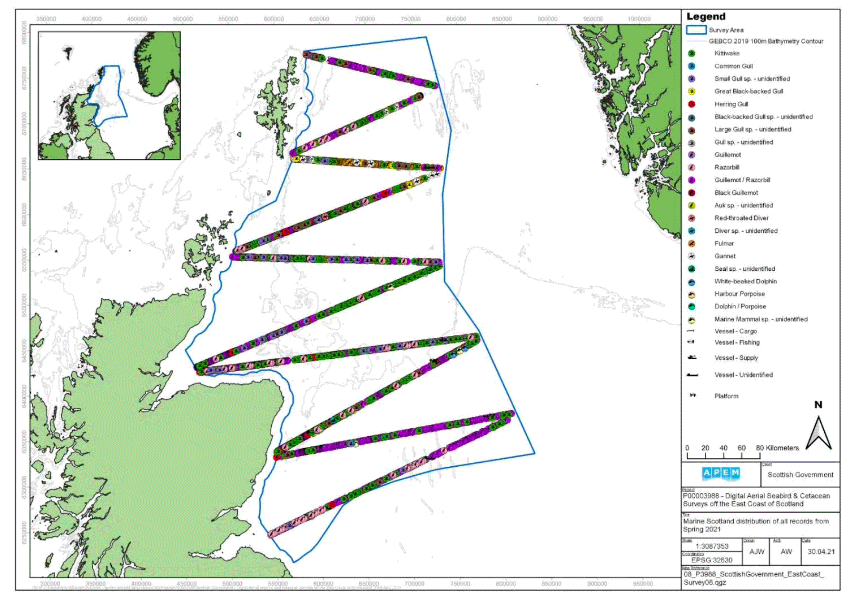
Figure Note: Individuals may appear to overlap if they are in close proximity to each other.
Contact
Email: REEAadmin@gov.scot
There is a problem
Thanks for your feedback